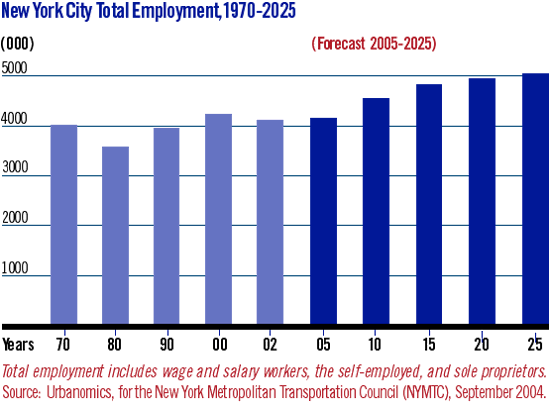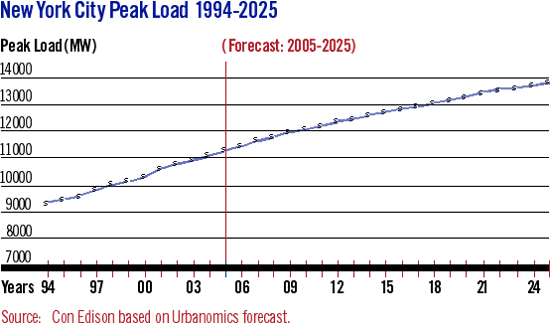Electricity Outlook 2010-2025
Page 2
The sizeable number of major new projects and developments that are underway, planned or proposed throughout all five boroughs exemplify the favorable outlook for growth in the City.
The rebuilding of the World Trade Center site is underway: construction of the #7 office tower is nearly complete, construction of the permanent PATH Station and the nearby Fulton Transit Center has begun, and groundwork is expected to start soon on the Freedom Tower.
Other major projects proposed or planned throughout the City include:
-
A substantial volume of new housing for all five boroughs by both the private and public sectors;
-
Office development of at least 44 million square feet to becompleted by 2025;
-
Major public capital projects, and new developments and expansions by universities and hospitals in the City;
-
Construction of 90 new schools throughout the five boroughs from
2005-2009, at a cost of more than $4.6 billion, as part of the New
York City School Construction Authority’s (SCA) capital plans, and SCA
renovations and expansions expected to cost twice that amount.
These projects will transform major districts throughout the City and add substantial new capacity for office, residential and commercial space, public facilities and transportation. All will require significant new electricity resources. The proposed Hudson Yards project alone is estimated to require 200 MW of electricity at the level of development assumed by 2025.2
It is expected that 6,000 to 7,000 MW of additional electric resources will be needed in New York City between now and 2025. This new capacity is required to accommodate growth, for replacement of existing power plants that will reach their useful age limitation during this time, and for stability of electricity prices.
Robust Growth Expected by 2025
Total jobs in New York City are expected to increase from 4.15 million in 2002 to 4.46 million in 2010, a gain of 315,000, or 7.6 percent. By 2025, total employment levels are forecast to reach 5.03 million, for a total gain of 887,300 jobs, a 21 percent increase over 2002.

The latest projections also suggest that New York City’s population could increase from the estimated level of 8,072,000 in 2002 to 8.4 million by 2010, a gain of over 400,000, and reach 9,352,500 by 2025 for a total gain of 1.28 million or 16 percent.
Population gains are expected to be largest in Queens, which is forecast to increase by 527,000 residents between 2000 and 2025, followed by 300,000 in Brooklyn, and 150,000 in Manhattan.
This population growth will require significant electricity resources to supply new households and the appliances they use.
The rate of electricity usage by households and offices has intensified in recent years, largely due to the increased use of air conditioning, computer equipment, and peripherals. Since 1990, this intensified usage has contributed to an annual increase in electricity demand averaging almost 1.5 percent per year. This trend is expected to continue throughout the forecast period, even as more efficient appliances and office equipment are used.
The planned projects, together with expectations for growth in employment and population, will require between 2,400 to 3,000 additional MW of new electric capacity in or directly connected to the City by 2025, just to accommodate peak load demand.

Plant Replacement
New generation facilities are needed to replace New York City’s aging power plants.Of the existing New York City electric generating capacity, plants producing the equivalent of 3,500 MW will be 60 years old or more in the next twenty years. Plants producing about 6,000 MW will be 45 years old or older by 2025.
It is assumed that approximately 3,000 MW of this aging generation capacity will have to be replaced by 2025. The newer facilities will be more energy efficient and feature better and cleaner technology, thereby providing important environmental benefits to the City.
Market Stability
To help avoid wide swings in the price of electricity in the newly deregulated electricity market, an estimated additional 1,000 MW of new electric capacity is needed by 2025.
For New York City to realize the expected growth in demand, there must be planning and approval mechanisms in place to assure that electricity and other energy resources are available.
Because the existing transmission system limits the amount of power that can be imported into the City, New York City is considered to be a ‘load pocket’. Consequently, the New York State Reliability Council (NYSRC) requires that 80 percent of peak load demand must be provided by electric capacity located within the five boroughs of New York City, or directly connected to the City’s electric distribution system.




